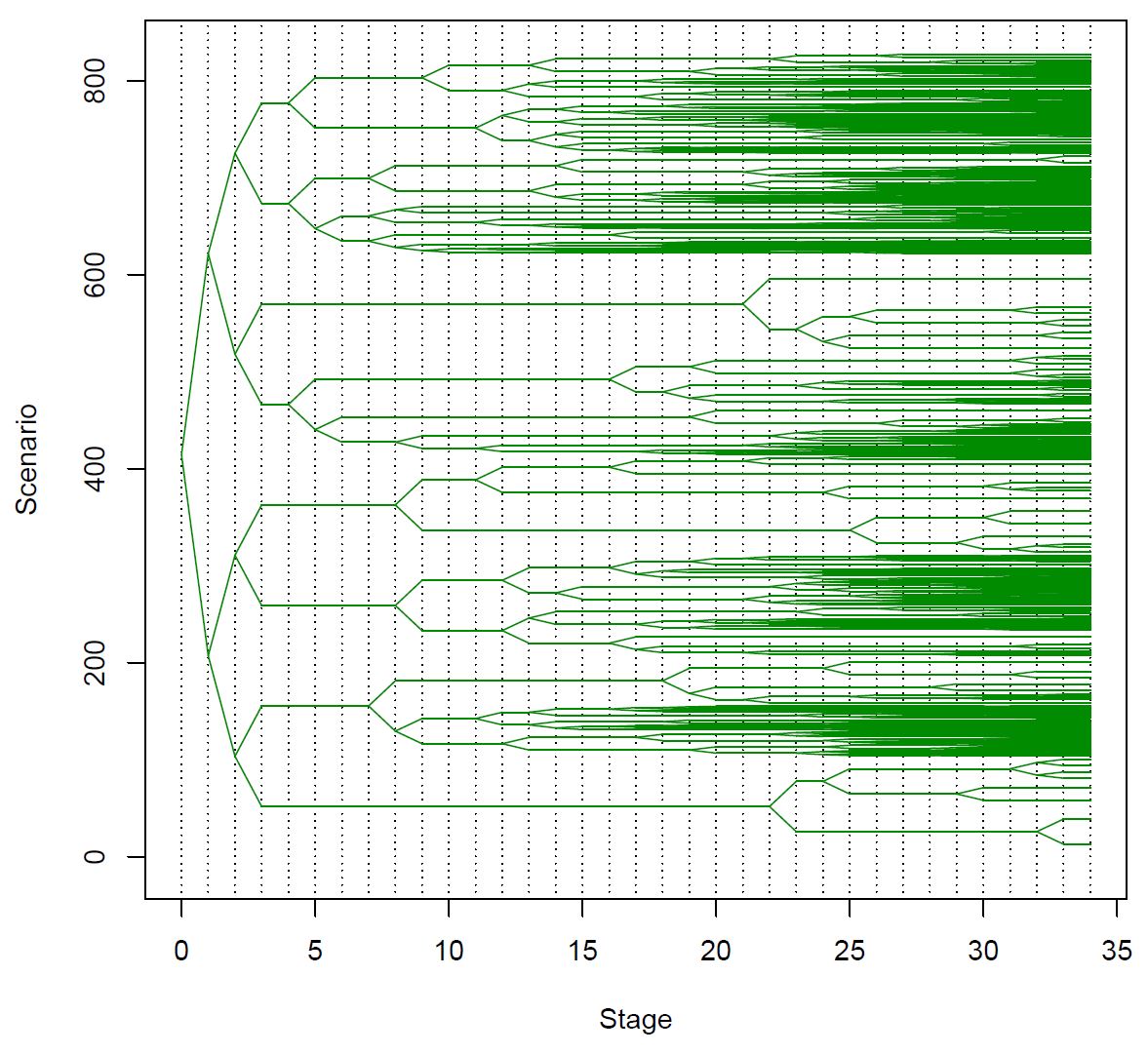multistage stochastic programming
Optimal Participation of Energy Communities in Electricity Markets under Uncertainty. A Multi-Stage Stochastic Programming Approach
Thu, 10/24/2024 - 11:48 — admin| Publication Type | Conference Paper |
| Year of Publication | 2024 |
| Authors | Albert Solà Vilalta, Marlyn Cuadrado, Ignasi Mañé, F.-Javier Heredia |
| Conference Name | ISMP2024, 25th International Symposium on Mathematical Programming |
| Conference Date | 21-26/07/2024 |
| Conference Location | Montréal, Canada. |
| Type of Work | Invited presentation |
| Key Words | energy communities; electricity markets; demand flexibility; prosumers; mathematical optimization; stochastic programming; research |
| Abstract | An energy community is a legal figure, recently coined by the European Union, that creates a framework to encourage active participation of citizens and local entities in the energy transition to net-zero. In this work, we study the optimal participation of energy communities in day-ahead, reserve, and intraday electricity markets. where energy communities cannot meet their internal demand, and periods where they generate excess electricity. This is because the electricity they generate often comes from variable renewable resources like solar and wind. Electricity market participation is a natural way to ensure they meet their internal demand at all times, and, simultaneously, make the most of the excess electricity. We propose a multi-stage stochastic programming model that captures variable renewable and electricity price uncertainty. The multi-stage aspect models the di¿erent times at which variable renewable generation is considered to be known and electricity prices from di¿erent markets are revealed. This results in a very large scenario tree with 34 stages, and hence a very large optimization problem. Scenario reduction techniques are applied to make the problem tractable. Case studies with real data are discussed, considering di¿erent energy community configurations, to analyse proposed regulatory frameworks in Europe. The added value of considering stochasticity in this problem is also analysed. The motivation to do so is that there are time periods |
| URL | Click Here |
| Export | Tagged XML BibTex |
Optimal Participation of Energy Communities in Electricity Markets under Uncertainty. A Multi-Stage Stochastic Programming Approach
Thu, 10/24/2024 - 11:36 — admin| Publication Type | Conference Paper |
| Year of Publication | 2024 |
| Authors | Albert Solà Vilalta, F.-Javier Heredia |
| Conference Name | EURO24, 33rd European Conference on Operational Research |
| Conference Date | 30/06-3/07/2024 |
| Conference Location | Technical University of Denmark (DTU), Copenhagen, Denmark. |
| Type of Work | Contributed presentation |
| Key Words | electricity markets; energy communities, mathematical optimization; stochastic programming; research |
| Abstract | An energy community is a legal figure, recently coined by the European Union, that creates a framework to encourage active participation of citizens and local entities in the energy transition to net-zero. In this work, we study the optimal participation of energy communities in day-ahead, reserve, and intraday electricity markets. The motivation to do so is that there are time periods where energy communities cannot meet their internal demand, and periods where they generate excess electricity. This is because most of the electricity they generate comes from variable renewable resources like solar and wind. Electricity market participation is a natural way to ensure they meet their internal demand at all times, and, simultaneously, make the most of the excess electricity. We propose a multi-stage stochastic programming model that captures variable renewable and electricity price uncertainty. The multi-stage aspect models the di erent times at which variable renewable generation is considered to be known and electricity prices from di erent markets are revealed. This results in a very large scenario tree with 34 stages, and hence a very large optimization problem. Scenario reduction techniques are applied to make the problem tractable. Case studies with real data are discussed, considering di erent energy community configurations, to analyse proposed regulatory frameworks in Europe. The added value of considering stochasticity in this problem is also analysed. |
| URL | Click Here |
| Export | Tagged XML BibTex |
Presentation at the EURO 2022 conference in Finland.
Fri, 07/08/2022 - 12:10 — admin
Last July 4 2022 I was invited at the EURO 2022 conference , Aalto University, Espoo, near Helsinki, to present the work Multistage stochastic programming for the optimal bid of a wind-thermal power production pool with battery storage, which is a continuation of the MSc and PhD thesis of Mr. Ignasi Manyé and Ms. Marlyn D. Cuadrado respectively. This work tackles with an extensive study along a complete timespan of on year analyzing the benefits of a joint operation of a wind and thermal generation system in the elecrticity markets and bilateral contracts. Numerical results show that the total profit increases by 13% in average, but that it can be as high as 77%, with a reduction of the thermal operation costs of 61%.
Multistage stochastic programming for the optimal bid of a wind-thermal power production pool with battery storage.
Fri, 07/08/2022 - 11:26 — admin| Publication Type | Conference Paper |
| Year of Publication | 2022 |
| Authors | F.-Javier Heredia; Ignasi Mañé; Marlyn Dayana Cuadrado Guevara |
| Conference Name | EURO 2022 |
| Conference Date | 03-06/07/2022 |
| Conference Location | Espoo, Finland. |
| Type of Work | Invited presentation |
| ISBN Number | 978-951-95254-1-9 |
| Key Words | research; multistage stochastic programming; virtual power plants; unit commitment |
| Abstract | In this study we present a multistage stochastic programming model to find the joint optimal bid to electricity markets of a pool of dispatchable (thermal) and non-dispatchable (wind) production units with battery storage facilities. The assumption is that these programming units are operated by the same utility that, previous to the market clearing, has to dispatch some bilateral contracts with the joint production of the production pool. The multistage model mimics the multimarket bidding process in the Iberian Electricity Market (MIBEL). First, the utility has to decide how to cover the energy of the bilateral contracts with the available units. Second, the production capacity of each unit, not allocated to the bilateral contracts, must be offered to the seven consecutives spot markets (day-ahead and six intraday markets) plus the secondary reserve market (the most relevant ancillary services market). The stochasticity of the electricity clearing prices and the hourly generation of the wind-power units is considered. The stochastic process associated to this multistage decision-making process is modelled through multistage scenario trees with thirty-four stages that are built from forecasting models based on real data of the Iberian Electricity Market. The numerical results show the advantage of the joint operation of the pool of production units with an increase of the overall expected profits, mainly due to a strong reduction of the operational costs. |
| URL | Click Here |
| Export | Tagged XML BibTex |
Multistage stochastic bid model for a wind-thermal power producer
Thu, 12/30/2021 - 13:20 — admin| Publication Type | Tesis de Grau i Màster // BSc and MSc Thesis |
| Year of Publication | 2021 |
| Authors | Ignasi Mañé Bosch |
| Director | F-Javier Heredia |
| Tipus de tesi | MSc Thesis |
| Titulació | Master in Statistics and Operations Reseafrch |
| Centre | Facultat de matemàtiques i Estadística |
| Data defensa | 18/10/2021 |
| Nota // mark | 9.5 |
| Key Words | teaching; electricity markets; multistage stochastic programming |
| Abstract | For many political and economic reasons, over the last decades, electricity markets in developed countries have been liberalised. Markets regulated by governments in which prices were set by the competent authority are now the exception. In this new setting, electricity agents, both consumers and producers, compete to maximise their pro tability in a series of auctions designed to efficiently match supply and demand. Many energy producers manage together wind and thermal generation units to meet their contractual obligations such as bilateral contracts, as well as bid on the electric market to sell their production capacity. This master thesis explore different multi-stage stochastic programming models for generation companies to nd optimal bid functions in electric spot markets. The explored models not only capture the uncertainty of electric prices of different markets and financial products, but also couples together wind and thermal generation units, offering producers that combine both technologies a more suitable approach to nd their best possible bidding strategy among the space of possible actions. |
| URL | Click Here |
| Export | Tagged XML BibTex |
Participation in the 31st European Conference on Operational Research.
Tue, 07/13/2021 - 11:24 — admin
Last July 21th, the work "Multistage Scenario Trees Generation for Electricity Markets Optimization" was presentated at the 31st European Conference on Operational Research in an invited session of the stream "Stochastic and Robust Optimization". This study is a result of the PH.D. Thesis of Ms. Marlyn D. Cuadrado on scenarios trees generation for multistage stochastic programming in optimal electricity bid problems.
Multistage Scenario Trees Generation for Electricity Markets Optimization
Tue, 07/13/2021 - 10:51 — admin| Publication Type | Conference Paper |
| Year of Publication | 2021 |
| Authors | Marlyn Dayana Cuadrado Guevara; F.-Javier Heredia |
| Conference Name | 31st European Conference on Operational Research. |
| Conference Date | 11-14/07/2021 |
| Conference Location | Athens |
| Type of Work | Invited presentation |
| ISBN Number | ISBN 978-618-85079-1-3 |
| Key Words | research; multistage stochastich programming; virtual power plants; electricity markets; scenarios tree generation |
| Abstract | The presence of renewables in electricity markets optimization have generated a high level of uncertainty in the data, which has led to a need for applying stochastic optimization to model this kind of problems. In this work, we apply Multistage Stochastic Programming (MSP) using scenario trees to represent energy prices and wind power generation. We developed a methodology of two phases where, in the first phase, a procedure to predict the next day for each random parameter of the MSP models is used, and, in the second phase, a set of scenario trees are built through Forward Tree Construction Algorithm (FTCA) and a modified Dynamic Tree Generation with a Flexible Bushiness Algorithm (DTGFBA). This methodology was used to generate scenario trees for the Multistage Stochastic Wind Battery Virtual Power Plant model (MSWBVPP model), which were based on MIBEL prices and wind power generation of a real wind farm in Spain. In addition, we solved three di erent case studies corresponding to three di erent hypotheses on the virtual power plant’s participation in electricity markets. Finally, we study the relative performance of the FTCA and DTGFBA scenario trees, analysing the value of the stochastic solution through the Forecasted Value of the Stochastic Solution (FVSS) and the classical VSS for the 366 daily instances of the MSWBVPP problem spanning a complete year. |
| URL | Click Here |
| Export | Tagged XML BibTex |
Ph D. Thesis on multistage scenario tree generation for renewable energies.
Mon, 11/30/2020 - 19:40 — admin On November 30th 2020 took place the defense of the Ph.D. Thesis entittled "Multistage Scenario Trees Generation for Renewable Energy Systems Optimization", authored by Ms. Marlyn D. Cuadrado Guevara and advised by prof. F.-Javier Heredia. In this thesis a new methodology to generate and validate probability scenario trees for multistage stochastic programming problems arising in two different energy systems with renewables are proposed. The first problem corresponds to the optimal bid to electricity markets of a virtual power plant that consists on a wind-power plant plus a battery storage energy systems. The second one is the optimal operation of a distribution grid with some photovoltaic production.
On November 30th 2020 took place the defense of the Ph.D. Thesis entittled "Multistage Scenario Trees Generation for Renewable Energy Systems Optimization", authored by Ms. Marlyn D. Cuadrado Guevara and advised by prof. F.-Javier Heredia. In this thesis a new methodology to generate and validate probability scenario trees for multistage stochastic programming problems arising in two different energy systems with renewables are proposed. The first problem corresponds to the optimal bid to electricity markets of a virtual power plant that consists on a wind-power plant plus a battery storage energy systems. The second one is the optimal operation of a distribution grid with some photovoltaic production.
Multistage Scenario Trees Generation for Renewable Energy Systems Optimization
Mon, 11/30/2020 - 19:17 — admin| Publication Type | Thesis |
| Year of Publication | 2020 |
| Authors | Marlyn Dayana Cuadrado Guevara |
| Academic Department | Dept. of Statistics and Operations Research. Prof. F.-Javier Heredia, advisor. |
| Number of Pages | 194 |
| University | Universitat Politècnica de Catalunya |
| City | Barcelona |
| Degree | PhD Thesis |
| Key Words | research; Battery energy storage systems; Electricity markets; Ancillary services market; Wind power generation; Virtual power plants; Multistage Stochastic programming; phd thesis |
| Abstract | The presence of renewables in energy systems optimization have generated a high level of uncertainty in the data, which has led to a need for applying stochastic optimization to modelling problems with this characteristic. The method followed in this thesis is Multistage Stochastic Programming (MSP). Central to MSP is the idea of representing uncertainty (which, in this case, is modelled with a stochastic process) using scenario trees. In this thesis, we developed a methodology that starts with available historical data; generates a set of scenarios for each random variable of the MSP model; defines individual scenarios that are used to build the initial stochastic process (as a fan or an initial scenario tree); and builds the final scenario trees that are the approximation of the stochastic process. |
| URL | Click Here |
| Export | Tagged XML BibTex |
A multistage stochastic programming model for the optimal bid of a wind producer
Wed, 07/11/2018 - 11:20 — admin| Publication Type | Conference Paper |
| Year of Publication | 2018 |
| Authors | F.-Javier Heredia; Marlyn D. Cuadrado; J.-Anton Sánchez |
| Conference Name | 23th International Symposium on Mathematical Programming |
| Conference Date | 01-06/07/2018 |
| Conference Location | Bordeaux |
| Type of Work | contributed presentation |
| Key Words | research; Battery energy storage systems; Electricity markets; Ancillary services market; Wind power generation; Virtual power plants; Stochastic programming |
| Abstract | Abstract: Battery Energy Storage Systems (BESS) can be used by wind producers to improve the operation of wind power plants (WPP) in electricity markets. Associating a wind power plant with a BESS (the so-called Virtual Power Plant (VPP)) provides utilities with a tool that converts uncertain wind power production into a dispatchable technology that can operate not only in spot and adjustment markets (day-ahead and intraday markets) but also in ancillary services markets that, up to now, were forbidden to non-dispatchable technologies. We present in this study a multi-stage stochastic programming model to find the optimal operation of a VPP in the day-ahead, intraday and secondary reserve markets while taking into account uncertainty in wind power generation and clearing prices (day-ahead, secondary reserve, intraday markets and system imbalances). A new forecasting procedure for the random variables involved in stochastic programming model has been developed. The forecasting model is based on Time Factor Series Analysis (TFSA) and gives suitable results while reducing the dimensionality of the forecasting mode. The quality of the scenario trees generated using the TFSA forecasting models with real electricity markets and wind production data has been analysed through multistage VSS. |
| URL | Click Here |
| Export | Tagged XML BibTex |
